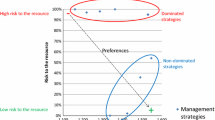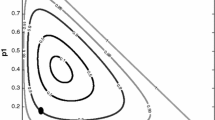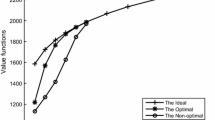Abstract
This paper presents a framework for the study of policy implementation in highly uncertain natural resource systems in which uncertainty cannot be characterized by probability distributions. We apply the framework to parametric uncertainty in the traditional Gordon–Schaefer model of a fishery to illustrate how performance can be sacrificed (traded-off) for reduced sensitivity and hence increased robustness, with respect to model parameter uncertainty. With sufficient data, our robustness–vulnerability analysis provides tools to discuss policy options. When less data are available, it can be used to inform the early stages of a learning process. Several key insights emerge from this analysis: (1) the classic optimal control policy can be very sensitive to parametric uncertainty, (2) even mild robustness properties are difficult to achieve for the simple Gordon–Schaefer model, and (3) achieving increased robustness with respect to some parameters (e.g., biological parameters) necessarily results in increased sensitivity (decreased robustness) with respect to other parameters (e.g., economic parameters). We thus illustrate fundamental robustness–vulnerability trade-offs and the limits to robust natural resource management. Finally, we use the framework to explore the effects of infrequent sampling and delays on policy performance.










Similar content being viewed by others
Notes
We use the terms “policies” and “control laws” interchangeably in this paper.
LTI means that the control laws are described by linear ordinary differential equations with constant coefficients.
To compare the performance of different policies as we do, the max–min criterion could be used but it would have to be normalized in some way. Our worst-case downside sensitivity is a particular choice of such a normalization.
While the sensitivity ordering for the small IC cases was obtained via simulation, the rankings for the parameters p, c, and δ were corroborated graphically using the easy-to-derive explicit small IC formula for the optimal return: \(J_o^* = \left [ \frac{ e^{-\delta t_e^*} - e^{-\delta T} }{\delta} \right ] \left [ \; p q x_e^* - c \; \right ] u_e^*\), \(t_e^* = \frac{1}{r} \ln \left [ \frac{x_e^*}{x_o} \left ( \frac{k - x_o}{k - x_e^*} \right ) \right ]\). This can be done because these parameters have no influence at all on the evolution of the state dynamics. For r, k, q, x o , limit cycles occur even for small perturbations. Given this, an explicit formula is impossible to obtain, and simulation becomes essential. Simulation is also needed for the large IC cases because an explicit formula is much harder to obtain—even for the economic parameters.
This required \(4\mathord{,}605 \times 61 \times 7 \times 4 = 7\mathord{,}865\mathord{,}340\) (nonlinear) simulations and took approximately 150 h or 70 ms per simulation on a Windows XP, 3.2 GHz, 1 GB RAM, 600 MFLOP PC.
To illustrate the ideas, we considered ±30% parametric uncertainty for all bioeconomic parameters of interest. In general, assuming uniform parametric uncertainty is unrealistic. The (decreasing) parameter uncertainty ordering k, x o , r, q, p, δ, and c is probably more reflective of reality. Studies with such nonuniform parametric uncertainty will be important for future work.
Our good controller regions (A for r, k, x o , and δ and E for p, c, and q) were selected on the basis of BOE, small IC. These controllers are generally not expected to perform well for BUE. If we sufficiently restrict the controllers within regions A and E to controllers near the optimal policy, then the resulting laws will perform well for BUE.
We also note that the discontinuities observed for the sensitivity in q are fundamentally due to the fact that different control laws can significantly impact the convexity properties of J(q). This will receive further attention in future work.
The reader should note that the claim \(\underline{S}_{c_o}^{J_o} = 0\) when u = 0 does not follow from the c o -sensitivity formula in Eq. 54: \(\underline{S}_{c_o}^{J_o} = S_{-} = - \frac{c_o}{J_o} \; \left ( \int_{0}^{T} e^{-\delta_o \tau} sat( u(\tau) ) \; d\tau \right ) < 0\). This is because the denominator term J o also goes to zero as u goes to zero. Our sensitivity reduction discussion shows that the claim is, in fact, true.
Here, the reader should interpret a “large” (or “small”) harvesting effort as one for which the exponentially weighted harvesting effort \(\int_{0}^T e^{-\delta \tau} {\mbox{sat}}(u(\tau) ) d\tau\) (roughly speaking) is large with respect to that associated with the optimal control policy. This idea is stated precisely for the economic parameters p, c, and δ within Technical Supplement TS.7.
It should be noted that for x o , this pattern is only observed for BOE. For BUE, the pattern is more complex and requires further investigation. This will be addressed in future work.
e.g., the standard one, two, and infinity norms: \({\left\Vert {\theta}_1\right\Vert} {\buildrel \rm def \over =} \sum_{i=1}^n |\theta_i|\), \({\left\Vert {\theta}_2\right\Vert} {\buildrel \rm def \over =} \sqrt{ \sum_{i=1}^n |\theta_i|^2 }\), \({\left\Vert {\theta}_{\infty}\right\Vert} {\buildrel \rm def \over =} {\rm max}_{i=1,\dots,n} |\theta_{i}|\).
References
Abaunza, P., Celso Fariña, A., & Murta, A. (2003). Applying biomass dynamic models to the southern horse mackerel stock (Atlantic Waters of Iberian Peninsula). A comparison with VPA-based methods. Scientia Marina, 67(Suppl. 1), 291–300.
Anderies, J. M., Rodriguez, A., Janssen, M., & Cifdaloz, O. (2007). Panaceas, uncertainty, and the robust control framework in sustainability science. Proceedings of the National Academy of Sciences of the United States of America, 104, 15194–15199.
Andersen, P. (1982). Commercial fisheries under price uncertainty. Journal of Environmental Economics and Management, 9(1), 11–28.
Babonneau, F., Vial, J. P., & Apparigliato, R. (2010). Robust optimization for environmental and energy planning. In J. A. Filar, & A. Haurie (Eds.), Uncertainty and environmental decision making. International series in operations research & management science (Vol. 138, no. 3, pp. 79–126). New York: Springer.
Belmiloudi, A. (2005). Nonlinear optimal control problems of degenerate parabolic equations with logistic time-varying delays of convolution type. Nonlinear Analysis-theory Methods & Applications, 63(8), 1126–1152.
Belmiloudi, A. (2006). Minimax control problems of periodic competing parabolic systems with logistic growth terms. International Journal of Control, 79(2), 150–161.
Ben-Tal, A., El-Ghaoui L., & Nemirovski, A. (2000). Robust semidefinite programming. In R. Saigal, L. Vandenberghe, & H. Wolkowicz (Eds.), Semidefinite programming and applications. Dordrecht: Kluwer.
Ben-Tal, A., & Nemirovski, A. (1998). Robust convex optimization. Mathematics of Operations Research, 23(4), 769–805.
Ben-Tal, A., & Nemirovski, A. (2002). Robust optimization—methodology and applications. Mathematical Programming, 92(3, Ser. B), 453–480. (ISMP 2000, Part 2, Atlanta, GA).
Ben-Tal, A., & Nemirovski, A. (2008). Selected topics in robust convex optimization. Mathematical Programming, 112(1), 125–158.
Bode, H. W. (1945). Network analysis and feedback amplifier design. Princeton: Van Nostrand.
Carpenter, S. A., Ludwig, D., & Brock, W. A. (1999). Management of eutrophication for lakes subject to potentially irreversible change. Ecological Applications, 9(3), 751–771.
Clark, C. (2006). Fisheries bioeconomics: Why is it so misunderstood? Population Ecology, 48, 95–98.
Clark, C. (2006). The worldwide crisis in fisheries: Economic models and human behavior. Cambridge: Cambridge University Press.
Clark, C., & Kirkwood, G. (1986). On uncertain renewable resource stocks—Optimal harvest policies and the value of stock surveys. Journal of Environmental Economics and Management, 13(3), 235–244.
Clark, C., Munro, G., & Sumaila, U. R. (2005). Subsidies, buybacks, and sustainable fisheries. Journal of Environmental Economics and Management, 50, 47–58.
Clark, C. W. (1990). Mathematical bioeconomics: The optimal management of renewable resources (2nd Ed.). New York: Wiley.
Dercole, F., Gragnani, A., Kuznetsov, Y. A., & Rinaldi, S. (2003). Numerical sliding bifurcation analysis: An application to a relay control system. IEEE Transactions on Circuits and Systems I—Fundamental Theory and Applications, 50(8), 1058–1063.
Gordon, H. (1954). The economic theory of a common property resource: The fishery. Journal of Political Economy, 62, 124–142.
Hansen, L. P., & Sargent, T. J. (2007). Robustness. Princeton: Princeton University Press.
Holland, D., Gudmundsson, E., & Gates, J. (1999). Do fishing vessel buyback programs work? A survey of the evidence. Marine Policy, 23, 47–69.
Holling, C. S. (1973). Resilience and stability of ecological systems. Annual Review of Ecology and Systematics, 4, 1–23.
Holling, C. S. (1986). The resilience of terrestrial ecosystems, local surprise and global change. In Clark, W. C., & Munn, R. E. (Eds.), Sustainable development of the biosphere (pp. 292–317). Cambridge: Cambridge University Press.
Holling, C. S., & Gunderson, L. H. (2002). Resilience and adaptive cycles. In L. H. Gunderson, & C. S. Holling (Eds.), Panarchy: Understanding transformations in systems of humans and nature (Chap. 2). Washington, DC: Island.
Infante, E. F., & Stein, J. L. (1973). Optimal growth with robust feedback control. The Review of Economic Studies, 40(1), 47–60.
ISRIC (1990). Global assessment of the status of human induced soil degradation (glasdod). Dataset. Wageningen: International Soil Reference and Information Centre.
Kendrick, D. A. (2005). Stochastic control for economic models: Past, present and the paths ahead. Journal of Economic Dynamics and Control, 29, 3–30.
Koenig, E. F. (1984). Controlling stock externalities in a common property fishery subject to uncertainty. Journal of Environmental Economics and Management, 11(2), 124–138.
Lauck, T., Clark, C., Mangel, M., & Munro, G. (1998). Implementing the precautionary principle in fisheries management through marine reserves. Ecological Applications, 8(1), S72–S78 (Supplement).
Lempert, R. J., Groves, D. G., Popper, S. W., & Bankes, S. C. (2006). A general, analytic method for generating robust strategies and narrative scenarios. Management Science, 52(4), 514–528.
Lempert, R. J., & Schlesinger, M. E. (2000). Robust strategies for abating climate change—An editorial essay. Climatic Change, 45(3–4), 387–401.
Luce, D. R., & Raiffa, H. (1957). Games and decisions: Introduction and critical survey. New York: Wiley.
Ludwig, D., Walker, B., & Holling, C. S. (1997). Sustainability, stability, and resilience. Conservation Ecology, 1(1), URL: http://www.consecol.org/vol1/iss1/art7/.
Ludwig, D., & Walters, C. (1982). Optimal harvesting with imprecise parameter estimates. Ecological Modelling, 14, 273–292.
Moran, E. F., & Ostrom, E. (Eds.) (2006). Seeing the forest and the trees: Human–environment interactions in forest ecosystems. Cambridge: MIT.
Myers, R., & Worm, B. (2003) Rapid worldwide depletion of predatory fish communities. Nature, 423, 280–283.
Rodriguez, A. A. (2003). Analysis and design of feedback control systems. Tempe: Control3D, LLC.
Rodriguez, A. A. (2004). Analysis and design of multivariable feedback control systems. Tempe: Control3D, LLC.
Schaefer, M. (1957). Some considerations of population dynamics and economics in relation to the management of the commercial marine fisheries. Journal of the Fisheries Research Board of Canada, 14(5), 669–681.
Sethi, G., Costello, C., Fisher, A., Hanemann, M., & Karp, L. (2005). Fishery management under multiple uncertainty. Journal of Environmental Economics and Management, 50(2), 300–318.
Shah, T., Molden, D., Sakthivadivel, R., & Seckler, D. (2000). The global groundwater situation: Overview of opportunities and challenges. Tech. rep., International Water Management Institute, Colombo, Sri Lanka.
Stinstra, E., & den Hertog, D. (2008). Robust optimization using computer experiments. European Journal of Operational Research, 191(3), 816–837.
Walters, C. (1986). Adaptive management of renewable resources. New York: MacMillan.
Wang, G. G., & Shan, S. (2007). Review of metamodeling techniques in support of engineering design optimization. Journal of Mechanical Design, 129(4), 370–380.
Weitzman, M. (2002). Landing fees vs harvest quotas with uncertain fish stocks. Journal of Environmental Economics and Management, 43(2), 325–338.
Wilen, J., & Homans, F. (1998). What do regulators do? Dynamic behavior of resource managers in the North Pacific Halibut Fishery 1935–1978. Ecological Economics, 24(2–3), 289–298.
Zhou, K., & Doyle, J. (1998). Essentials of robust control. Upper Saddle River: Prentice Hall.
Acknowledgements
The authors would like to thank Elinor Ostrom, William Brock, Charles Perrings, and Ann Kinzig for helpful comments on earlier drafts of this manuscript.
Author information
Authors and Affiliations
Corresponding author
Additional information
The authors gratefully acknowledge financial support for this work under National Science Foundation grant BCS-0527744.
Rights and permissions
About this article
Cite this article
Rodriguez, A.A., Cifdaloz, O., Anderies, J.M. et al. Confronting Management Challenges in Highly Uncertain Natural Resource Systems: a Robustness–Vulnerability Trade-off Approach. Environ Model Assess 16, 15–36 (2011). https://doi.org/10.1007/s10666-010-9229-z
Received:
Accepted:
Published:
Issue Date:
DOI: https://doi.org/10.1007/s10666-010-9229-z




